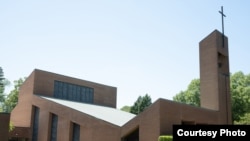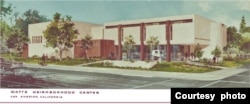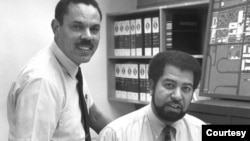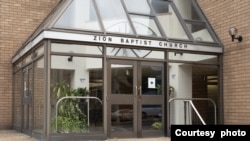“He came out of the school of architecture at USC (University of Southern California) right after World War II, and there was a major housing crisis similar to what we're dealing with now,” says Gail Kennard, the architect’s daughter. “He and many of his classmates saw modernism as a tool to use to house people. … The architecture in modernism was simple — simple lines, light, simple structures, simple materials that were affordable for many people.”
By the 1960s, Kennard shifted his focus to public buildings. His designs include three parking structures at Los Angeles International Airport and a headquarters of the Los Angeles Police Department. In collaboration with other architects, Kennard, who died in 1995, also designed the city hall building in Carson, California, and the Watts Happening Cultural Center in South Los Angeles.
Both of those structures have been targeted for long-term funding and conservation by the African American Cultural Heritage Action Fund, a program of the National Trust for Historic Preservation, which is dedicated to saving historic sites in the United States.
“The real significance of this program is that Black architects and their design contribution in American history has been undervalued and overlooked,” says Brent Leggs, executive director of the Action Fund and senior vice president of the National Trust. “And, in partnership with Getty, we are committed to correcting this historical inequity.”
The Getty Foundation got involved after realizing that none of the 77 grants it had awarded to help conserve modern buildings in the United States were designed by Black architects. Getty partnered with the Action Fund to create a $3.1 million grant program to preserve 16 modernist structures by Black architects and designers.
The purpose of the Conserving Black Modernism program is to highlight the ingenuity and creativity of Black architects. Leggs says places that are important in the Black American experience have not been centered as an integral part of American history.
“The absence of recognition is itself a kind of trauma, and so the work of the Action Fund is to mitigate these historical inequities and to uplift the beautiful, complex and full-lived experience of Black Americans in recent history and over the last four centuries,” Leggs says. “It is a form of education and truth telling. It can foster racial reconciliation and healing.”
The first grant round identifies eight historic structures that will receive $1.2 million for long-term preservation planning. The grantees were selected after a seven-month review process and will receive $150,000 each in the coming months.
Gail Kennard is thrilled that two of her father’s projects made the list.
“He was devoted to modernism. He didn't do any work that was actually outside of that style, so he’d be really happy,” she says.
She now runs the Kennard Design Group firm that her father founded.
“And the fact that they are two buildings that serve the community, the Watts Happening Cultural Center, which is still around and serving the Watts community, and Carson City Hall, which is serving the Carson community, it's just wonderful,” she says.
Modernist architecture is generally known for its minimalist lines, rectangular shapes and lack of adornment.
“We've noticed within Black modernism that there are other design attributes that respond to culture, place and community,” Leggs says. “American modernism has often been viewed through a Eurocentric lens. And so, when we nuance this through a distinctive lens of culture and socioeconomic factors, Black modernism stands as a unique form of architecture and design.”
In addition to the Kennard projects, the eight sites chosen for preservation planning funding include the Charles McAfee Swimming Pool and Pool House in Wichita, Kansas, designed by Charles McAfee; First Baptist Church-West in Charlotte, North Carolina, designed by Harvey Gantt; Morgan State University’s Jenkins Hall in Baltimore, Maryland, designed by Louis Edwin Fry; Second Baptist Church of Detroit’s Education Building in Michigan, designed by Nathan Johnson; Zion Baptist Church in Philadelphia, Pennsylvania, designed by Walter Livingston, Jr.; and Fourth Baptist Church’s Educational Wing in Richmond, Virginia, the only structure on the list designed by a Black woman, a self-taught architect named Ethel Bailey Furman.
“The structures tell us that when all Americans are given opportunity and access to education, that the outcome can be permanent demonstrations of their potential,” Leggs says. “Like the work of Robert Kennard, as a co-designer of the Carson City Hall building in California, which stands as the sublime piece of modern architecture. Without access to education, he would have never been able to create such an impactful and lasting piece of American architecture.”
Gail Kennard describes herself as “over-the-moon excited” that her father’s work has been recognized in this way, especially considering the difficulties he faced when starting out as a Black architect.
“When he graduated, he was at the top of his class,” she says. “He had won the top design award in his class, and he sent out his resumes and no one would hire him. They didn't hire colored architects, so he was discouraged. But fortuitously, one of the architects in Pasadena did hire him, so he got a chance.”
That opportunity resulted in pioneering modernist structures that continue to serve the community many decades after they were built.




